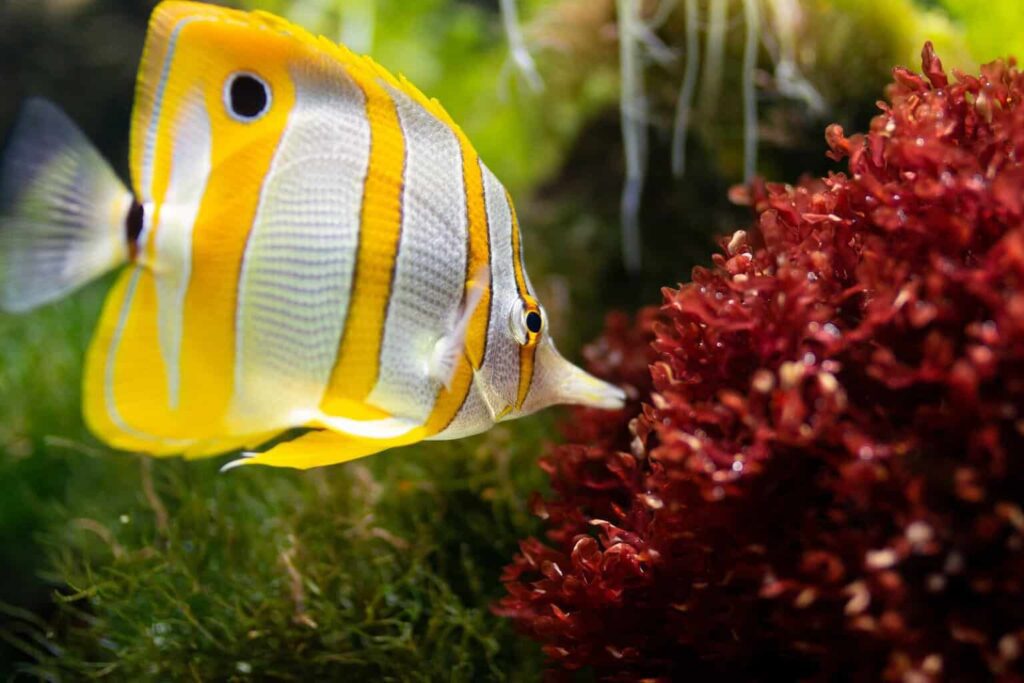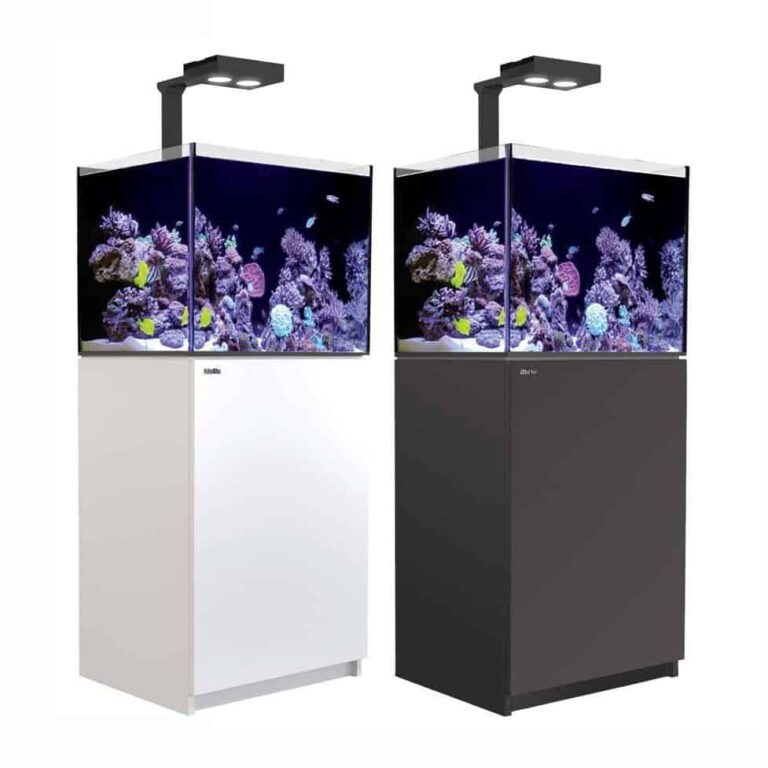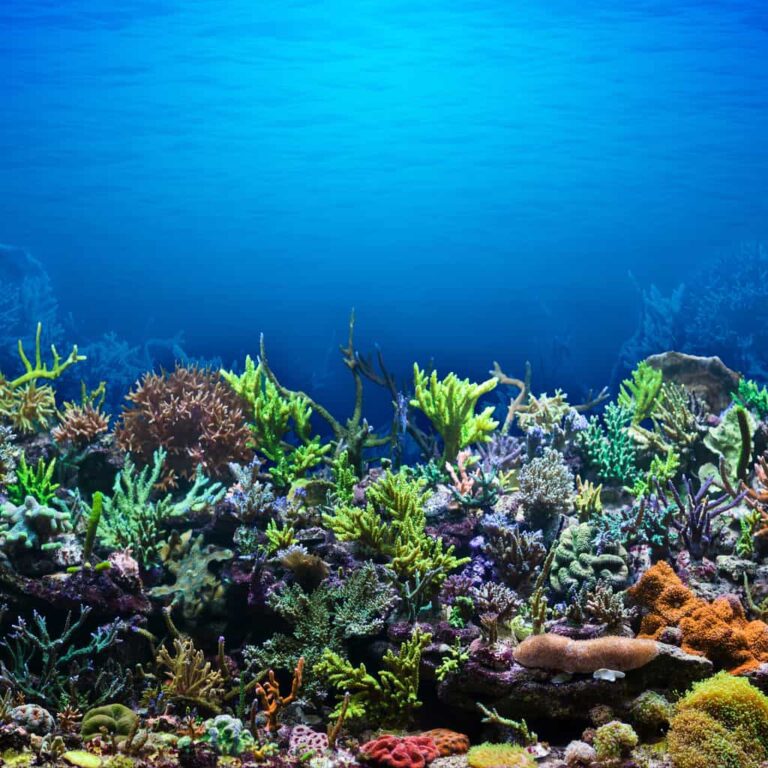The first thing you need to know when it comes to buying fish for a saltwater aquarium is about their compatibility. Some fish are peaceful towards others and there are some fish that attack everything they see. Without knowing whether a particular fish can reside with other tank mates peacefully or not can lead to a disaster quickly.
Some fish just aren’t compatible with one another for a few reasons but what it all boils down to is competition. All living organism in the ocean compete for one thing or another to eat, stay alive and reproduce.

Different Types of Compatibility Issues
There are mostly five types of compatibility issues:
- Predator & Prey
- Protection of Territory
- Protection of Mate & Status
- Protection of Spawn
- Greedy Feeding Behavior
Predator & Prey
The Predator & Prey category is self-explanatory. This aggressive behavior occurs when the recipients are seen as food, such as an ornamental shrimp being eaten by a Dragon Moray Eel. It’s not a great idea to keep large predatory fish with any small fish they may consider food. These fish are best kept in a community tank for predatory fish, with fish like Hawks, Groupers and Snappers.
Protection of Territory
This aggressive behavior occurs when other fish of a similar or the same species attack another. Most fish react similarly to territorial aggression, often times when you add a new fish to the tank after the aquarium has already been established with some fish.
It’s best to add new fish at the same time to an aquarium. They may have a few territorial disputes until the dust settles. However, harassment may occur when new fish are introduced to a tank community that has already been established — regardless of the species of fish is added.
Protection of Mate & Status
An example of this type of aggressive behavior is when a pair of mated fish attack others. It should be noted that most species display this kind of behavior. Usually what happens is when a mated pair of fish already inhabit a tank and a new fish of the same species is added, the fish of the same sex will go after the other one that was introduced. It’s a wise idea to limit a tank to one pair of mates per species.
Protection of Spawn
This type of aggression is seen when a fish protects its nesting area and spawn from other fish who may come close to it. To limit this type of behavior, it’s best to keep spawning fish in larger tanks and provide plenty of space for them to nest — and ample room for the other fish in the tank, as well.
Greedy Feeding Behavior
All other invertebrates and fish display this sort of aggression. The types of fish that show this behavior should be kept in a tank for aggressive specific species. Often times, Lions fishes are kept only in tanks with Lions, Triggerfish with Triggerfishes, and other species that are larger
Predatory Fish Tanks
The following types of fish may be kept together in a predatory fish tank –
- Puffers
- Large Tangs
- Lionfish
- Squirrelfish
- Groupers
- Large Angels
- Triggers
- Large Butterflies
- PredatoryWrasses
Predator Types
- Nippers – The size of the prey does not matter here. This type of predator will bite and nip until dead.
- Gulpers – Gulpers swallow their prey in one bite. If they can’t swallow it at once, they will not be interested. Some examples of gulpers are: lionfish, groupers and anglers).
What Are Reef Safe Fish
When it comes to reef tank things become more sensitive. Reef safe fishes are those species that are not only good for a community saltwater aquarium but also don’t possess any threat to the corals if put in a reef tank. Simply put, they don’t consume corals.
10 Best Reef Safe Fish
These fish can live together peacefully in a reef tank. I recommend these 10 fish types because they are suitable for virtually any reef setup or community tank.
1. Orchid Dottyback
Stats:
- Temperament: Semi-Aggressive
- Minimum Tank Size: 30 Gallons
- Max Size: 3 Inches
This is an awesome fish which generally gets a bad rap, unfortunately. Dottybacks can wreak havoc in your aquarium. However, Orchid Dottybacks are much less aggressive than other types of dottytbacks. Their temperament is mild and they are great tank mates in a community aquarium. Unless you are buying a mated pair, it’s not a good idea to keep a pair of these. It’s not easy to tell the difference between the sexes and they can’t change gender. These little fish are perfect for a saltwater tank.
2. Firefish
 Stats:
Stats:
- Temperament: Peaceful
- Minimum Tank Size: 10 Gallons
- Max Size: 3 Inches
For nano tanks (really small aquariums), this is an excellent choice. Firefish have striking colors, are quite and peaceful, and are extremely hardy. These fish can be kept in pairs but if doing so, this should be done when they are young to increase the likelihood of success. These fish are timid and may be harassed by others in the tank who are more aggressive.
3. Clownfish
 Stats:
Stats:
- Temperament: Semi-Aggressive to Peaceful
- Minimum Tank Size: 20 Gallons
- Max Size: 3 Inches
These are the most popular choice for saltwater aquariums in the industry. You can find many types of designer clownfish these days. If you want a pair, they should either be introduced at the same time when young or you may get one smaller and one larger fish. Clownfish will host corals and can spawn in captivity. Your reef tank will be incomplete if it’s missing a pair of clownfish.
Additional Read: Clownfish Tank Mates
4. Blue Green Chromis
Stats:
- Temperament: Peaceful
- Minimum Tank Size: 30 Gallons
- Max Size: 3.5 Inches
These fish will school together, and they are very long-lived and hardy. Blue green chromis are to saltwater tanks what neon-tetra are to freshwater aquariums. You just can’t make a mistake by having these fish in your reef tank.
5. Midas Blenny
Stats:
- Temperament: Peaceful
- Minimum Tank Size: 30 Gallons
- Max Size: 6 Inches
These are the perfect blenny fish. They have great personalities, are very colorful and are safe for reef tanks. Many people say these are their favorite fish in their aquarium. They constantly move as they do not have a swim bladder and they have an eel like appearance while swimming.
6. Six Line Wrasse
Stats:
- Temperament: Semi-Aggressive
- Minimum Tank Size: 30 Gallons
- Max Size: 3 Inches
These wrasses are very active, hardy and reef-safe. They can be a little aggressive and may harass fish that are easily intimidated. They do very well with other fish that are semi-aggressive (like clownfish) and should be added to the tank last to avoid any drama.
7. Banggai Cardinalfish
Stats:
- Temperament: Semi-Aggressive to Peaceful
- Minimum Tank Size: 30 Gallons
- Max Size: 3 Inches
This iconic saltwater fish has striking black lines, a great personality, and is peaceful with other tank mates. They do well in pairs and can spawn in captivity.
8. Watchman Goby
Stats:
- Temperament: Peaceful
- Minimum Tank Size: 30 Gallons
- Max Size: 3 Inches
This fish is an excellent choice for beginners. They will form a pair if introduced to a pistol shrimp. If this is what you are going to do, make sure you have at least a 2” sandbed and get a small shrimp such as a candy cane shrimp. Watchman gobies do well on their own too.
9. Royal Gramma
Stats:
- Temperament: Semi-Aggressive
- Minimum Tank Size: 30 Gallons
- Max Size: 3 Inches
This gorgeous fish comes with a great personality and a beautiful blend of colors. If there are no clownfish, angelfish or tangs present, they may try to be boss of your tank. Royal grammas can be aggressive toward fish with similar bodies. Do not mix with another royal gramma or a dottyback as they can’t be kept in the same tank.
10. Carpenter’s Wrasse
Stats:
- Temperament: Peaceful
- Minimum Tank Size: 55 Gallons
- Max Size: 3 Inches
This fish requires a large tank. It’s best to keep these in groups because males will perform a display of colors to the females in the aquarium. Keep in mind you will need to introduce the fish either as a group or the females first. These fish can change genders. These fish are less aggressive so should be added to the tank first. Also, these guys can jump so always use a cover over your tank.
Introducing Fish to Your Reef Tank
Care should be taken when keeping fish together of the same shape, color and/or size, especially if they come from the same genus.
Always add peaceful reef fish to the tank first so they can develop their territory. Add fish that are more aggressive last.
If there is a concern that two fish may not get along, they should be added at the same time. Otherwise, if you add one of them first, it will sense the entire tank as its territory.
If you’re a beginner saltwater tank enthusiast, first try keeping some hardy fish until you gain more experience.






